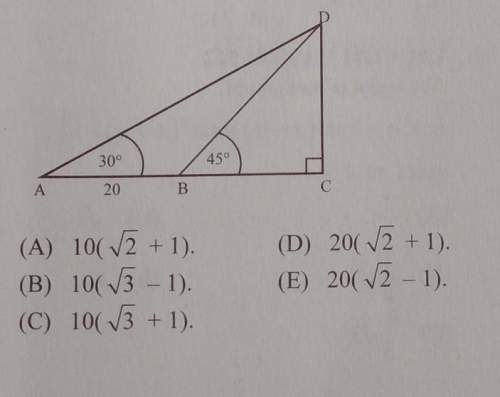In the acd triangle picture above, if cbd = 45°, cad = 30°, ab = 20, then bc =
...

Mathematics, 20.10.2019 10:10 Senotora
In the acd triangle picture above, if cbd = 45°, cad = 30°, ab = 20, then bc =


Answers: 1


Other questions on the subject: Mathematics

Mathematics, 20.06.2019 18:04, genyjoannerubiera
30 points! i am confused. what does it mean by game time? you can use a table of random numbers or a random number generator to create random samples. also, you can obtain random samples directly using wolframalpha. com. for example, typing in randomsample[{1,2,3,4,5},2] will give you a sample of size 2 from the list {1,2,3,4,5}. a sample result is {1,5}. refreshing the page will generate a new random sample of size 2. 2. create five random samples of size two from the population. record the game times for the samples and calculate the mean game time of each sample. 3. create 5 random samples of size 11 from the population. record the game times for the samples and calculate the mean game time of each sample.
Answers: 2

Mathematics, 21.06.2019 15:30, annalisamorris0
Aiden drives to school and back each day. the school is 16 miles from his home. he averages 40 miles per hour on his way to school. if his trip takes 1 hour, at approximately what speed does aiden drive home?
Answers: 1

Mathematics, 21.06.2019 17:00, SillyEve
In tossing one coin 10 times, what are your chances for tossing a head? a tail? 2. in tossing one coin 100 times, what are your chances for tossing a head? a tail? 3. in tossing one coin 200 times, what are your chances for tossing a head? a tail? deviation = ((absolute value of the difference between expected heads and observed heads) + (absolute value of the difference between expected tails and observed tails)) divided by total number of tosses. this value should always be positive. 4. what is the deviation for 10 tosses? 5. what is the deviation for the 100 tosses? 6. what is the deviation for 200 tosses? 7. how does increasing the total number of coin tosses from 10 to 100 affect the deviation? 8. how does increasing the total number of tosses from 100 to 200 affect the deviation? 9. what two important probability principles were established in this exercise? 10. the percent of occurrence is the obtained results divided by the total tosses and multiplied by 100%. toss the coins 100 times and record your results. calculate the percent occurrence for each combination. percent head-head occurrence: percent tail-tail occurrence: percent head-tail occurrence:
Answers: 3

Mathematics, 21.06.2019 20:00, Enaszr9657
Two line segments are shown in the figure below. suppose that the length of the line along the x-axis is 6, and the length of the hypotenuse of the triangle is 10. what is the equation of the hypotenuse line (shown in red, below)?
Answers: 3
You know the right answer?
Questions in other subjects:

Mathematics, 19.07.2019 13:30



Biology, 19.07.2019 13:30

Social Studies, 19.07.2019 13:30

History, 19.07.2019 13:30




Social Studies, 19.07.2019 13:30



